10 tips to stay safe when running during the day or at night
You can never be too safe when running, whether during the day or late in the evening – use these ten tips to get started.

The topic of safety has never been more prevalent, with more runners and people more scared than ever to run alone, both during the daytime and at night. This is an awful position to be in and no runner should be left to feel this way. Of course, we hope things can change in the coming months and years, however, whether or not that is realistic is another story entirely.
There are countless news reports of women being chased or attacked while out running – the world is a scary place and one that requires change more than ever. Nonetheless, to keep you safe, we’ve provided you general running at night safety tips such as wearing reflective gear alongside other tips greater focused on staying safe when running alone (e.g. sticking to populated areas).
So, share this post with a friend, a loved one, or read it a couple of times, you can never be too safe – here are ten tips for running during the daylight or at night.
Related: Running at night – what you need to know.
1. Run facing traffic
No matter what time of day you run, we recommend that you run facing the traffic while on the roads. This will improve your visibility and allow you to make judgements as to whether you need to make a swift turn out of the way. Always assume the worst out of drivers, as this will keep you safe.
If possible, when running around blind corners, you should run on the grass. Alternatively, do your best to make yourself seen or switch sides of the road depending on the current traffic and how safe it is. Usually, this is common sense, however, a little guidance doesn’t hurt!
2. Make use of the daylight

Running in the dark is far more dangerous than running during the day. Running during the day when it’s light outside allows you to see where you’re going and more importantly, increases your visibility to other road users. Furthermore, there are far fewer incidents and assaults in broad daylight as there are usually more people around.
Second, make use of cycle tracks and regular running routes, ideally routes where you’ll pass other runners and walkers. Avoid alleys, poorly lit areas, and definitely parts of a city or town you wouldn’t usually go when it’s light… you should also wear reflective gear to remain visible to passerbys and other road and cycle track users.
If running at night is a little too intimidating, you could instead run on a treadmill, attend a local gym class or perform a home workout or circuit session. If time constraints prevent you from running during the day, you could also run in the morning before work/school when it’s light out (especially during the hot summer months).
Finally, as a general rule of thumb: if on your regular running route you often don’t see at least a handful of people, you should consider mixing your route up to a more populated area, increasing your safety and reducing the likelihood of an attack.
3. Wear reflective gear
Investing in a few pieces of reflective gear is an easy way to stay safe while running, especially when running at night. If possible, wear bright yellows, greens, and oranges with reflective patches to remain visible. If you’re going to be running in the dark, we also suggest investing in light-up running armbands or a running head torch to further increase visibility – these are essential pieces of kit all runners should own.
4. Be aware of your surroundings

Being aware of your surroundings is possibly the most important factor in regards to staying safe while running. As much as we all enjoy ‘getting in the zone,’ ensure you’re still tapped into what is going on around you. Watch for traffic, pedestrians, and most importantly, where you’re going.
If running with music, we recommend only listening through one earphone or turning your music down when running through crowded city streets, isolated areas, or when running on the road. This will increase your awareness and reduce the risk of any accidents or incidents – so stay aware!
5. Run with a friend
One of the safest ways to stay safe is by running with a friend. Hitting the pavements with a friend allows you to look out for one another while still being able to push each other during your run. If anything is to happen, the other can contact the required emergency services, but fingers crossed it doesn’t come to this!
You can also run with a running group, further increasing your safety when running at night and definitely scaring off potential attacks and other illicit behaviour.
6. Track your run and share the GPS data real-time
Various smartphone apps (and smartwatches) provide real-time GPS tracking and data. For example, Strava’s summit beacon (a premium feature) allows you to share GPS data with friends or loved ones, enabling them to monitor your run in real-time, becoming instantly aware of any unusual activity or directional changes during your run or walk.
This feature can provide peace of mind, an invaluable tool for those running alone at night.
7. Always run with your phone
You should always run with a phone on hand. If you happen to pull up midway through your run with an injury, you can ring for a lift or ring for help if needed. Ensure to save your emergency contacts, and let another person know when you’re running, roughly how long you’ll be running for, and your estimated time of return. If any of this is to change, you can simply shoot them a text.
8. Research the area you will be running in

Research the different areas you are considering running in. This is especially important if running in new locations or on holiday. This can easily be done online and will allow you to map your run accordingly. Remember, even if you have to take a different route safety should be your top priority.
You can use route planners to do this, an easy to use method, with some of these tools allowing you to follow along live once created.
9. Abandon the earphones completely
If you feel particularly uneasy about running alone whether during the day or at night, then it’s best to ditch the earphones completely. This allows you to focus on your environment and those around you – the more you know what’s going on, the more you can do to protect yourself should an incident occur.
You should definitely ditch the earphones if running in isolated areas with little to no people. This reduces the likelihood of someone sneaking up behind you or even scaring you unintentionally. If you can’t run without your headphones, then do your best to run in more populated areas for extra protection.
10. Carry some form of identification, just in case
When running, whether this is at night or during the day, you should always carry some form of identification on you, whether a wristband with an emergency contact number or something as simple as your driver’s license. In the event of an accident or incident, first responders will be able to contact your friends or family.
Frequently asked questions
To finish, we’ve created a short FAQ surrounding safety when running at night (and during the day), see this below:
How do you stay safe running at night?
We recommend running with a friend when possible, GPS tracking your run, running in more populated areas (if possible), and to always be aware of your surroundings, whether you're running in the city or the countryside.
Is it dangerous to go for a run at night?
Running at night is considerably more dangerous than running during the early afternoon or the evening. This is because usually it's darker and there are fewer people around, especially in more remote areas.
Is it safe to run early in the morning?
If it is light out by the time you've laced up your running shoes, then running in the morning should be safer. However, this does depend on your individual situation and location, so make a calculated decision (e.g. if there are people around or not & if you can contact a friend for help if required).

Matthew is a lifelong runner, chief tester of all products, the founder of Running101, and freelance content writer for active brands. When he’s not writing, he enjoys lifting weights, cycling in the Lake District, and watching fast cars drive in circles on a Sunday. He also has a BA in sport, exercise and physical activity from the University of Durham.





